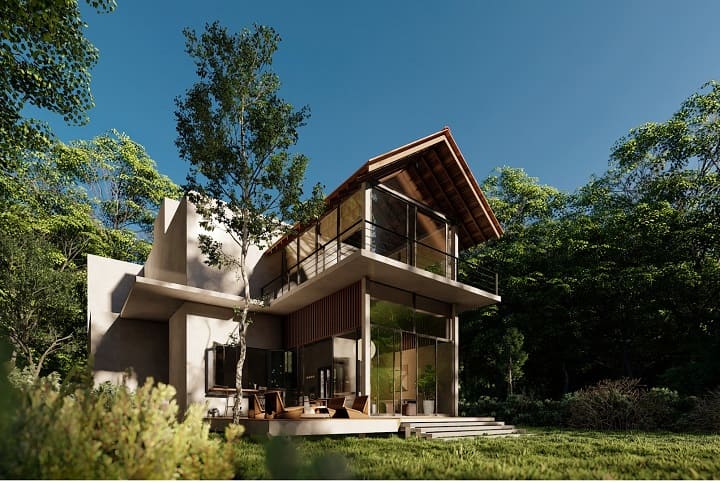Due to the fierce competition in the real estate market, brokers and developers must constantly innovate to sell their properties effectively. With so many options, purchasers are looking for listings that stand out from the competition. And those are the properties frequently marketed through aesthetically pleasing components like exterior 3D renderings.
As you continue reading, you’ll understand why exterior 3D house rendering has become a popular technique in real estate marketing. We’ll talk about the significance of this brand-new visual tool and how it can help you sell your properties.
The Power of 3D Exterior Renderings
Imagine being able to view your ideal house before it is even constructed. The capacity to create emotions and ambitions in prospective customers using 3D exterior renderings is unparalleled. Traditional designs cannot compare to the realistic and immersive experience these visualizations provide. With the development of rendering technology, it is now possible to capture every architectural detail, texture, and lighting to produce an image practically identical to a photograph of the completed property.
In addition, with 3D exterior renderings, architects and developers can now work together with greater success, as design ideas and changes may be communicated more efficiently. These representations’ visual clarity makes it simpler to iterate on design concepts and make wise decisions that result in a more polished final product.
Enhancing Real Estate Marketing Strategies
Particularly in the cutthroat real estate market, first impressions count. Making a good first impression on potential customers is made possible with 3D exterior representations. Developers can highlight a property’s best characteristics by showcasing its façade from multiple perspectives and under varying lighting situations. These renderings capture the character of the property and help make an image that will stay, whether it be the opulent façade of a luxury condominium or the charming rusticity of a suburban home.
Furthermore, 3D rendering-powered virtual property tours are redefining how customers interact with listings. From the comfort of their own home, buyers may examine every inch of a property. This not only saves time but also enables purchasers to decide whether a property fits their interests and way of life.
Marketing initiatives can also benefit from 3D renderings’ adaptability. Developers can use these graphics in print and digital materials to develop unified marketing campaigns that appeal to their target market. These representations’ visual charm attracts prospective purchasers, piques their interest, and compels them to discover more about the property.
Breaking Down the Technical Process
A great 3D exterior rendering requires a careful balancing act between technical accuracy and aesthetic imagination. The first step is to capture the landscape and structure characteristics accurately. To ensure accurate reproduction, every detail—from the sun’s angle to the bricks’ texture—is painstakingly replicated.
The magic really happens when lighting, textures, and materials are combined. Professional renderers recreate real-world lighting conditions using sophisticated software, giving the images more depth and realism. To emulate the feel of various surfaces, whether it is the smoothness of glass or the roughness of stone, textures and materials are carefully chosen.
The trick, though, is striking a balance between artistic interpretation and realism. There is room for creativity, even if the objective is to produce visually stunning and genuine images. The rendering process enables minor enhancements that might distinguish a building, such as emphasizing specific architectural aspects or boosting the intensity of colors.
Tailoring Designs to Different Audiences
The versatility of 3D exterior renderings to accommodate various property types and buyer demographics is one of their most impressive features. To appeal to a variety of audiences, the same property can be portrayed in various ways. For instance, a modernist townhouse may be offered to a tech-savvy urban demographic with sleek lines and minimal landscaping, or the same property could be presented with a more traditional aesthetic to appeal to individuals who value traditional charm.
Additionally, 3D renderings let designers consider several design possibilities. You might be interested in how a property would appear with a new roof design or landscaping strategy. These ideas can come to life through renderings, which help clients make better design choices.
Collaboration and Communication
The potential of 3D exterior renderings to promote collaboration and communication among stakeholders is a frequently overlooked benefit. Now, while discussing design concepts, architects, developers, and clients can all be on the same page. Renderings’ visual clarity reduces misconceptions and guarantees that everyone involved in the project has the same shared vision.
This component of collaboration goes beyond the original design stage. Any alterations or revisions can be communicated more clearly through visual references as the project develops. This lowers the possibility of misunderstandings and speeds up the decision-making process.
Overcoming Challenges and Limitations
While 3D exterior renderings have many benefits, they also have their share of drawbacks. The requirement to control client expectations is one potential barrier. Despite how realistic these drawings may seem, there might still be a few slight differences between them and the actual building. To make sure that clients are aware of the technological constraints and any potential deviations that can occur during construction, developers and architects must actively engage with them.
Budget and scheduling limits are another difficulty. High-end 3D renderings need trained specialists and pricey, sophisticated software to be produced. Furthermore, the rendering procedure itself can take a while. Developers must strike a compromise between spending money on high-quality renderings and finishing projects on time.
The Future Landscape of Real Estate Marketing
The development of 3D rendering technology offers a preview of real estate marketing in the future. Potential purchasers may soon be able to visually tour properties because of the development of virtual reality (VR) and augmented reality (AR). This degree of participation raises the bar for engagement and provides a wholly immersive experience with enduring value.
Rendering techniques will probably grow increasingly more advanced as technology develops. It will become more difficult to distinguish between produced graphics and actual photographs as the line between the two continues to blur. Keeping up with the most recent trends and adopting them into their strategies will be necessary for developers and marketing experts to adjust to these developments.
Exterior 3D Renderings: Ushering in a New Era of Real Estate Marketing
Although the era of blueprints is far from ended, 3D exterior renderings have unquestionably changed the real estate market. Beyond the constraints of conventional visual representation, these renderings provide prospective purchasers with an immersive experience that arouses their emotions and feeds their aspirations. Real estate professionals must embrace the revolutionary potential of 3D renderings as the industry develops to take advantage of their ability to make enduring impressions and reimagine how properties are advertised and represented. 3D exterior renderings have actually gone above and beyond blueprints in the dynamic field of real estate, where innovation is crucial, ushering in a new era of excellence.




































